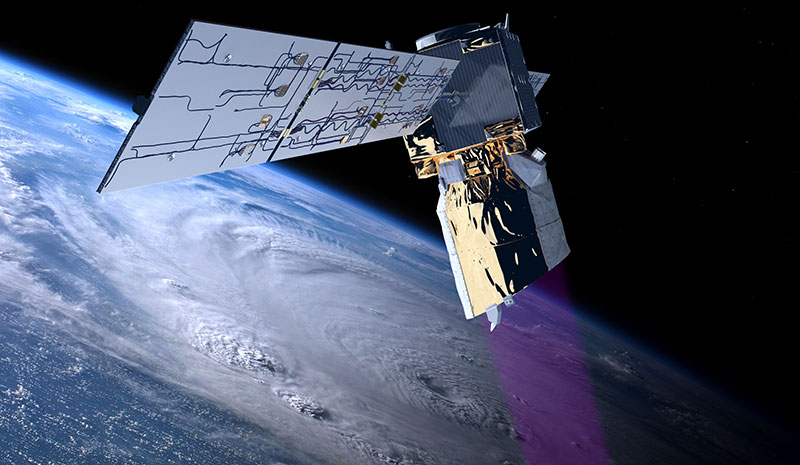- News
- Meet a young researcher who us...
Meet a young researcher who uses Aeolus data to measure atmospheric gravity waves
22 Apr 2022

Researcher Timothy Banyard, from the University of Bath, hopes to improve weather forecasting through the measurement of gravity waves (GWs). While GWs are difficult to measure due to their scale size and location, Tim recently demonstrated the Earth Explorer Aeolus' ability to observe GWs over the Southern Andes during the austral winter of 2021.
At the recent Aeolus Third Anniversary Conference in Taormina, Sicily, Tim presented his research with a poster entitled "Atmospheric Gravity Waves in Aeolus Wind Lidar Observations", which was very well received.
The ESA Earth Explorers are a family of research missions, which use advanced space technologies to answer critical scientific questions about how Earth functions as a system and how human activity is affecting its natural processes. Aeolus was the fifth Earth Explorer mission to be launched and hosts the first space-based Doppler wind lidar worldwide. It is the first satellite mission to deliver profiles of Earth's wind globally, and the mission's data are being used to advance research in atmospheric dynamics.
Of specific interest to Tim, is Aeolus' ability to provide unique high-resolution measurements of horizontal wind in the upper-troposphere/lower-stratosphere (UTLS).
Tim's passion for weather began during his childhood in Wolverhampton. Following an undergraduate degree in Physics at the University of Warwick, Tim went on to do a Master's Degree in Atmosphere, Ocean and Climate at the University of Reading, which provided him with a strong foundation in atmospheric dynamics, as well as weather forecasting. Although Tim's research interests are broad, as he aims to understand meteorology, numerical weather prediction and the atmosphere as a whole, for his doctorate he has chosen to focus on stratospheric dynamics, the stratosphere being the second layer of the atmosphere above the troposphere. In particular, Tim studies GWs, which are important drivers of the global atmospheric circulation.
ESA: Why is stratospheric dynamics so interesting?
Tim: If you want to understand the global atmospheric circulation as a whole, it isn't enough to just look at surface pressure charts. Those measurements will indeed show you what is happening on the surface of Earth, but if you wish to forecast further ahead, say two or four weeks ahead, then you need to know what's going on higher up. We know a lot about the weather on the surface, having hundreds of years of observations of Earth's surface weather, but we don't have observations going back that far on the stratosphere. That's why I am so interested in the stratosphere, because we know less about that area of the atmosphere than the surface.

ESA: How and when did you decide you wanted to focus on Earth Observation?
Tim: Often the community is split into two halves - those working on models and simulations and those working on observations. At Reading I did a lot of work on models, and I wanted to add Earth Observation data into that, since I believe Earth observation is absolutely critical to the success and development of future models. I wanted to look at raw observations to see if the models we have are good enough. Looking at raw Earth observation data, in this case Aeolus data, is really exciting because it's not just nice, simulated data – you have to work with it to exclude the bad data and find the good data. When I take Aeolus data, I first do a quality control and then gridding, before I use it for my research.
ESA: How did this project come to life?
Tim: My research group focuses on atmospheric GWs in the stratosphere and troposphere, but also the mesosphere and thermosphere, so right the way up in the atmosphere. We study global circulation and things that impact the weather on long time scales, and thus the climate. GWs are really important drivers of this global atmospheric circulation. My supervisor is Dr Corwin Wright, at the Centre for Space, Atmospheric and Oceanic Science at the University of Bath. We jointly received funding from the UKRI Engineering and Physical Sciences Research Council and the Royal Society, and work in collaboration with the Met Office.
ESA: What are gravity waves?
Tim: Gravity waves are not to be confused with gravitational waves, which for example may be produced by a black hole in outer space. GWs form in Earth's atmosphere and are similar to the ripples when a rock is thrown in a lake. The atmosphere acts like a fluid – so when the wind hits a mountain you get ripples which propagate upwards and downwind in waves of varying frequencies. These waves carry energy and momentum, and as they move upwards where the atmosphere becomes less dense, the energy of the waves increases until the waves break, depositing their energy and driving the atmospheric circulation. For many years weather models didn't properly take into account the effect of GWs, so that's why measuring them are so important to improve our forecast models.
ESA: What makes Aeolus special?
Tim: This project is about exploiting the novel wind measurements from Aeolus. Aeolus is a really interesting satellite, and the first of its kind. Previously we did have measurements of GWs, but most of them are measuring radiances, i.e. temperature perturbations, and often these measurements are made locally, for example using weather balloons in a fixed location. But if you really want to understand GWs, you want to do that from a wind-based framework. Now, thanks to Aeolus, for the first time we have global measurements of wind, which is a different parameter and very unique. These measurements have unlocked evidence of GWs and allowed us to test out some theories on GWs. However, probably the most important aspect of Aeolus is that it provides high resolution measurements from the UTLS layer of the atmosphere, where we have fewer measurements available.

ESA: What is your favourite memory of the Aeolus 3rd Anniversary workshop?
Tim: As well as presenting a poster about my research, I co-chaired a science session at the workshop, where I was amazed by how many diverse applications there are for Aeolus data. It is remarkable to see the many areas where researchers are using the data - ranging from measuring ocean waves and the response of the ocean to wind, to researching Saharan dust and aerosol patterns, as well as comparing results with atmospheric motion vectors which infer wind speeds by looking at the movement of clouds.
Read more about Tim's project.
Join us at ESA's Living Planet Symposium in Bonn
Being held on 23–27 May 2022 in Bonn, Germany, ESA's prestigious Living Planet Symposium offers attendees the unique opportunity to hear first-hand about the most recent developments in the field of Earth observation. Attendees will be able to hear about the latest scientific findings on our planet and how observing Earth from space supports environmental research and action to combat the climate crisis, learn about novel space technologies and about the new opportunities emerging in the rapidly changing sector of Earth observation. This exciting event not only attracts scientists and academics, but also those working in the space industry, institutional stakeholders, data users, students and citizens – an amazing opportunity to all meet in-person after the Covid pandemic.
More information and registration details can be found at the Living Planet Symposium website.